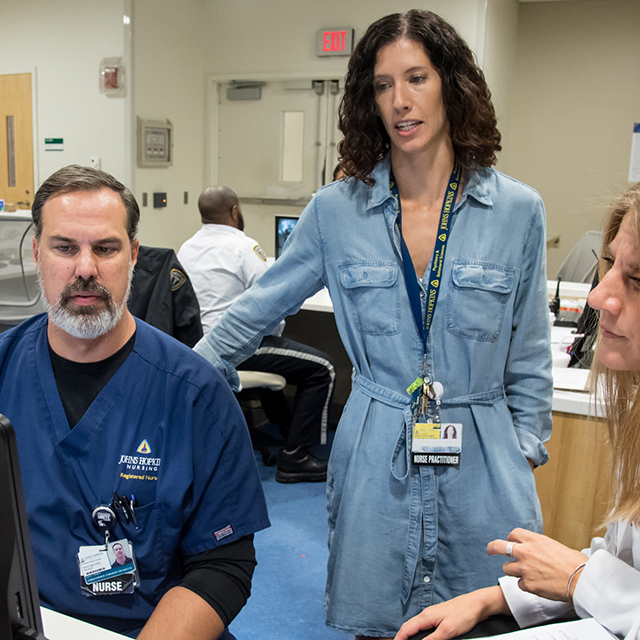After an overnight stay in the psychiatric emergency services area of Johns Hopkins Bayview Medical Center, the young man insists his suicidal crisis has subsided.
“He tells me he’s ready to go home,” the consulting physician says to Anne Marie Domacasse, a social worker who evaluates patients who come through the hospital’s emergency department.
Domacasse tells the doctor that she suspects the patient, Mr. S, is still suicidal. In her four years at Johns Hopkins Bayview, she’s seen him in the emergency department before, and she is familiar with his case and his living circumstances.
“He Googled different ways to kill himself,” Domacasse tells the physician. “He looked for a gun that he knew his father had, but it was gone. He stood on top of a garage, but didn’t think it was high enough.”
As the doctor studies the electronic patient record, the social worker continues. “He thinks about suicide almost every day.”
Such check-ins between a mental health evaluator and a psychiatrist or psychiatric nurse practitioner must occur before any psychiatric patient is discharged from the medical center. Today, Domacasse and the consulting physician agree that this patient is not yet ready to leave. They discuss options to keep him hospitalized, as well as possible treatments.
When they determine a patient is at risk of suicide, members of the health care team can make a legal declaration that a patient be held involuntarily at another facility. But because treatment will be easier — and possibly more effective — with the patient’s cooperation, they prefer to have Mr. S’s consent and admit him for psychiatric care.
“Do you think you can talk him out of wanting to leave?” the physician asks Domacasse. She pauses for a beat before nodding her head.
“I think I can, yeah.”
Improving the Johns Hopkins Bayview Psychiatric ED Experience
All emergency patients are first screened by an attending physician or provider who performs initial medical investigations and treatments. Although any patient admitted to the ED is the direct responsibility of the attending ED physician, the Department of Psychiatry and Behavioral Sciences provides 24/7 consultation services for those patients deemed to need psychiatric care.
The psychiatric emergency services area accommodates up to 10 patients. It is staffed with specialized psychiatric nurses who provide care and ensure the patients’ safety.
Bayview psychiatric emergency nurse Andrea Strawther says that efforts to establish trust begin as soon as the patient arrives and continue throughout the patient’s stay.
“With all 10 beds almost always full, we work hard to keep things calm and safe for everyone,” says Strawther. “Once we get a patient stabilized, we look for any changes in their behavior. If we notice any changes in body language, or maybe a lack of eye contact, we pay attention right away and try to maintain stability.
“So often, if feels like if one patient destabilizes, we can expect a domino effect in the others.”
Domacasse is part of a team of mental health professionals charged with evaluating, monitoring and referring patients who come to the center with psychiatric emergencies. Once nurses make sure patients are medically stable, psychiatric evaluators such as Domacasse assess their conditions and help formulate a plan for care.
A consulting psychiatrist or a psychiatric nurse practitioner makes rounds each morning, communicating with the on-site team, as well as the ED’s attending physician.
Process, workflow and communication are critical. Since the 2017 completion of the emergency department at the North Pavilion, two standing meetings have improved and streamlined the way the team provides care to emergency psychiatric patients.
First, Arjun Chanmugam, director of the Hopkins Bayview ED, appointed Giorgio Galetto, an ED faculty member, to serve as the department’s liaison for streamlining psychiatric emergency care. Galetto initiated a biweekly meeting with Karin Neufeld, the clinical director of Bayview psychiatry; Freddie Jenkins, director of nursing for psychiatry; and Cynthia Walters, director of nursing for the ED.
Additionally, a larger committee, which includes hospital administrators; emergency physicians; psychiatrists; regulatory, safety and security staff; mental health evaluators; and nurse managers — representing both psychiatry and emergency medicine — gathers regularly to discuss the issues and policies affecting care of patients with psychiatric emergencies.
“We’ve built relationships between departments that haven’t always been able to communicate as easily as we do now,” says Neufeld. “These meetings have brought real teamwork to our psychiatric emergency care.”
Each patient’s concerns are different, says Laurie Burdock, who manages the mental health evaluator and peer recovery coaching staff in the ED.
She points to one way the committee has advanced the treatment of patients with substance use disorders: In years past, patients undergoing withdrawal from opioids received medicine to control nausea and other gastric symptoms.
“Now we use an evidence-based opioid withdrawal scale to determine the safety of treating the patient with buprenorphine,” she says, referring to a drug used to treat opioid addiction. “When we see withdrawal, we can dose a patient correctly in the emergency room and start treatment right away.”
Other committee improvements include shortening the time it takes to get laboratory tests, emergency medications and help when patients are unable to control their behavior. Emergency department nurses now ask patients about their substance use habits during the triage process. They refer those identified as having problems with alcohol or drug use to a peer recovery coach who helps find resources for long-term treatment after discharge from the ED.
Patients with psychoses, personality disorders, anxiety and other conditions often need care beyond what a hospital can provide. Among the greatest challenges the psychiatric ED team faces, Burdock says, is connecting patients with outside mental health care.
The mental health evaluators spend much of their time contacting local psychiatric offices and clinics to find appropriate follow-up appointments for patients ready for discharge.
“The resources for patients with mental health needs are scarce,” says Burdock. “But our team is good at finding them.”
“He understood that he needs help”
Between seeing patients, Domacasse and her colleague, social worker Desaray Smith, document their findings in the medical record while sitting in the team workroom in the psychiatric emergency services area. One desk wraps halfway around the tiny space, with computers and printers nestled tightly together on it.
The largest computer monitor sits in a corner of the desk, where anyone in the room can see it. This security camera screen displays 12 black-and-white video feeds, offering a wide view of each patient area. Domacasse and Smith regularly glance at the screen.
“Sometimes we have patients who are agitated,” Domacasse says. “They may be suffering from psychotic symptoms such as delusions. We watch to make sure they don’t hurt themselves, and try to help if the nurses need us.”
In another corner, a dry-erase board holds a constantly changing grid, showing each patient’s care and disposition. An asterisk indicates that an elderly woman has been certified as an involuntary admission to an outside psychiatric facility; Johns Hopkins Bayview hospitalizes only those patients who voluntarily agree to psychiatric treatment.
Strawther, the psychiatric nurse, enters the room, walks to the dry erase board and erases the woman’s name. On the security monitor, Smith watches a uniformed security staff member push the woman’s wheelchair toward the exit. Domacasse says the patient will transfer to Levindale, a geriatric hospital in northwest Baltimore.
Meanwhile, Domacasse has convinced Mr. S to remain under care. “It didn’t take much,” she tells the ED attending physician. “When I talked with him, he understood that he needs help.”
The staff will transfer him to the hospital’s inpatient psychiatric unit and his name, too, will come off the board.



